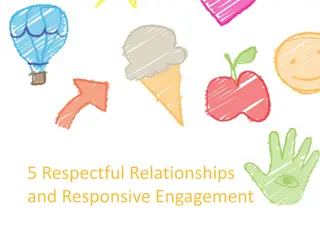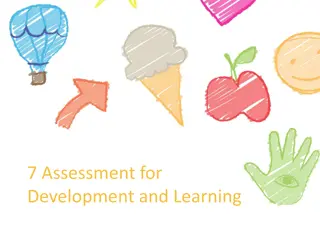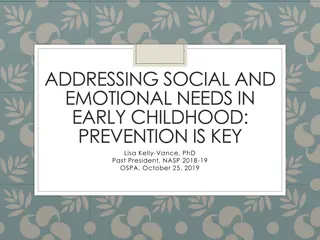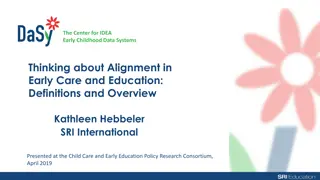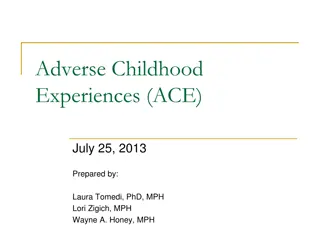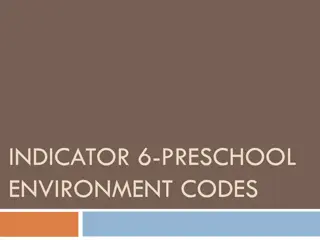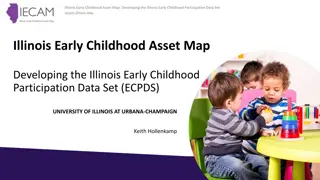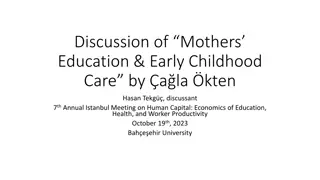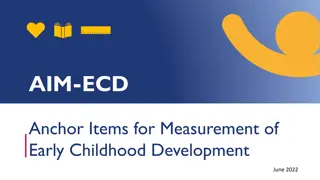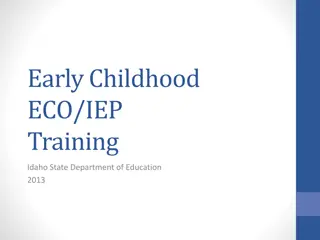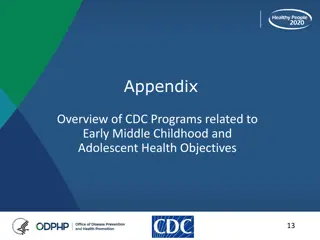Developing Common Data Systems for Early Childhood Programs
Explore the benefits and challenges of establishing data systems for Part C and 619 programs using common data elements and definitions. Learn about the Align and Connect tools developed by the CEDS initiative for shared data dictionaries and analytic strategies. Discover the significance of Common Education Data Standards in improving outcomes for early childhood education. Join the discussion on CEDS usefulness, development process, and relevance to Part C and 619 programs.
Download Presentation

Please find below an Image/Link to download the presentation.
The content on the website is provided AS IS for your information and personal use only. It may not be sold, licensed, or shared on other websites without obtaining consent from the author.If you encounter any issues during the download, it is possible that the publisher has removed the file from their server.
You are allowed to download the files provided on this website for personal or commercial use, subject to the condition that they are used lawfully. All files are the property of their respective owners.
The content on the website is provided AS IS for your information and personal use only. It may not be sold, licensed, or shared on other websites without obtaining consent from the author.
E N D
Presentation Transcript
The Center for IDEA Early Childhood Data Systems CEDS: Common Data Elements and Definitions for Part C and 619 Programs Missy Cochenour, Applied Engineering Management Haidee Bernstein, Westat Denise Mauzy, Applied Engineering Management Improving Data, Improving Outcomes Conference September 15-17, 2013 Washington, DC
Session Description Discuss the benefits and challenges of developing data systems across Part C and Part B/619 programs with common data elements and definitions. Have a Hands On opportunity to explore the Align and Connect tools developed by the CEDS initiative. Experience the power of shared data dictionaries, shared evaluation and research questions, and shared analytic strategies. Learn a new wayto answer important program and policy questions. 2
Agenda Introduction: Missy Cochenour Demonstration of Align: Missy Cochenour Hands On Align session/ short break: Group work Demonstration of Connect: Missy Cochenour Hands On Connect Session: Group work 3
CEDS OVERVIEW Why is CEDS useful to you? ? What are the Common Education Data Standards? ? How have they been developed? ? Who developed CEDS, specifically in early learning? ? 4
What are your Interests? Are you working in your state to develop a common data vocabulary? Are you currently using CEDS? 5
What is CEDS? A vocabulary including standard definitions, option sets, and technical specifications to streamline sharing and comparing information A national collaborative effort to develop voluntary, common data standards for a key set of education data elements Voluntary Common Vocabulary CEDS 101 Common Education Data Standards http://ceds.ed.gov/ 6
Does CEDS relate to Part C and 619? Common Education Data Standards Education - Sounds like it doesn t include Head Start, Child Care, and Part C non-Education lead agencies Standards - Sounds like it refers to benchmarks or criteria that data would have to meet Common (mis) Conclusions: CEDS does not include or relate to Part C and Section 619. OR If CEDS does include Part C and 619, it means more requirements coming down from U.S. Department of Education. 7
Why is DaSy talking about CEDS? DaSy Goal: To develop and enhance statewide early childhood coordinated and longitudinal data systems to improve state capacity to collect, analyze, and report high quality data required under IDEA ALIGN: Addresses reporting high quality data by providing common data dictionaries (elements, option sets, and technical specifications) CONNECT: Facilitates data analysis by recommending analytic approaches (logic and formulas) to address program and policy questions as well as Federal reporting requirements (indicators) Enhances capacity for coordinated and longitudinal analysis by including data elements in different domains across the P-20W continuum 8
Why CEDS in EC?
Same or Different File? Maria Lopez D.O.B. 3/25/2009 Maria L. Lopez D.O.B. 3/25/2009 939 Howard Street Homestead, FL 33030 1010 Spruce Street Fresno CA 93706 Mother: Inez Lopez Father: Juan Lopez Mother: Inez Lopez Father: Juan Pablo Lopez HEAD START FILE HEAD START FILE 10
Same or Different File It is the same file. This migrant family moves seasonally to find work What elements should be added to help someone determine that it is the same file? 11
Same or Different File? J. D. Stone 123 Harper Street West Hempstead, NY 11552 D.O.B. 9/13/2012 J. D. Stone 123 Harper Street West Hempstead, NY 11552 D.O. B. 9/13/2012 E. I. Program Nassau County E.I. Program Nassau County 12
Same or Different? They are twins with different files. What elements should be added to help someone determine that it is the same file? 13
Imagine... A child from Early Learning Program A also enrolls in Early Intervention Part C services that use a different education data standard. CEDS 101 Common Education Data Standards http://ceds.ed.gov/ 14
Heres a child: Matthe SmithIII Race = Guamanian Gender = M Did you mean: Matthew ? Smith ? Suffix = III ? Race = NHOPI ? Sex = M ? CEDS 101 Common Education Data Standards http://ceds.ed.gov/ 15
CEDS Tools A Robust & Expanding Common, Voluntary Vocabulary drawn from existing sources Powerful Stakeholder Tools & Models Connect Logical Data Model Align CEDS 101 Common Education Data Standards http://ceds.ed.gov/ 17
CEDS 101 Common Education Data Standards http://ceds.ed.gov/ 18
CEDS Anatomy: The Basics
Standard Information: The Basics Element Definition Hispanic or Latino Ethnicity Option set Yes No NotSelected Domain Entity K12 K12 Student CEDS 101 Common Education Data Standards http://ceds.ed.gov/ 20
Early Childhood Enrollment Service Type CEDS 101 Common Education Data Standards http://ceds.ed.gov/ 21
Service Entry and Exit Dates CEDS 101 Common Education Data Standards http://ceds.ed.gov/ 22
Prior Early Childhood Experience CEDS 101 Common Education Data Standards http://ceds.ed.gov/ 23
Program Type CEDS 101 Common Education Data Standards http://ceds.ed.gov/ 24
Personnel Qualification Status CEDS 101 Common Education Data Standards http://ceds.ed.gov/ 25
Potential New Data Elements for Version 4 Service Description Service Frequency Service Intensity Service Setting
Data Element Details CEDS 101 Common Education Data Standards http://ceds.ed.gov/ 27
State Example: Data Elements Building new data system OR Expanding or revising existing data system CEDS provides a jump start
USING ALIGN CEDS 101 Common Education Data Standards http://ceds.ed.gov/ 29
Align Web-based tool that allows users to Import or input their data dictionaries Align their current data to CEDS Compare their data dictionaries Analyze their data in relation to various other CEDS-aligned efforts CEDS 101 Common Education Data Standards http://ceds.ed.gov/ 30
States with Early Learning Maps CEDS 101 Common Education Data Standards http://ceds.ed.gov/ 31
Aligning to CEDS CEDS 101 Common Education Data Standards http://ceds.ed.gov/ 32
Aligning to Others CEDS 101 Common Education Data Standards http://ceds.ed.gov/ 33
State Example: Align Tool State plans to link data collected by Early Hearing Detection & Intervention (EHDI) with Part C data to guide program improvement and for CDC reporting. Each agency can create a map using the Align tool to simplify the process of linking data sets.
Lets Practice Using Align User Name: USER1 Password: T3sting! 35
USING CONNECT CEDS 101 Common Education Data Standards http://ceds.ed.gov/ 36
Connect Stakeholders from various types of educational organizations can use the tool to Answer program and policy questions Calculate metrics and indicators Address reporting requirements CEDS 101 Common Education Data Standards http://ceds.ed.gov/ 37
Using CEDS to Answer Program & Policy Questions: Part C/619 Example What percentage of children with an IFSP or IEP are currently enrolled in each early learning program setting? To answer such a program question, you need Data, possibly from multiple data systems Data elements and their definitions A plan to analyze the data . . . You need the CEDS Connect tool. 38
Available Connections CEDS 101 Common Education Data Standards http://ceds.ed.gov/ 39
myConnect CEDS 101 Common Education Data Standards http://ceds.ed.gov/ 40
myConnect CEDS 101 Common Education Data Standards http://ceds.ed.gov/ 41
State Example: Connect Tool State serves young children under Part C and Part B/619. State has developed a tiered quality rating and improvement system (QRIS). Policymakers want to know if children with disabilities who participate in a highly rated program experience better outcomes. They have posed this question to the Part C and 619 Coordinators. Where to start? 42
Lets Practice Using Connect User Name: USER1 Password: T3sting! 43
CEDS Roundtables (Tuesday at 8:00 a.m.) Opportunity to offer an early intervention/preschool special education perspective Topic-driven, facilitated roundtable discussions IFSP Planned and Delivered Services Assessment Transitions Eligibility Referral Your opportunity to provide feedback and input Are there elements not in CEDS which might be required to support Part C or 619? Do you have recommendations for changes?
Wrap-Up Do you better understand the benefits of CEDS? Have you become more familiar with CEDS? Are you ready to explore using CEDS once you return home? What are your TA needs in relation to CEDS? 45
Engage with CEDS http://ceds.ed.gov





